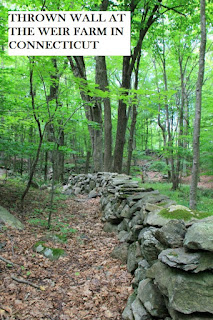"Julian Alden Weir’s most successful landscape paintings of his Branchville farm all share a few of his simple truths: sun-drenched fields contain both beautiful vistas and unsightly dying trees. Common subjects are beautiful and worth examining. Weir’s paintings are filled with impediments that intentionally slow down how fast a viewer can observe the painting. The wetlands, boulders, trees, fences, and stone walls in Autumn are the visual representation of Weir’s belief that one must spend time in nature before nature reveals its beauty.
Autumn is on view in the Weir House."
Bulletin of the Massachusetts Archaeological Society, Vol. 77, No. 2 (Fall 2016)
https://vc.bridgew.edu/cgi/viewcontent.cgi?article=1202&context=bmas
Notes:
Meadows
During the Weir and Young tenures, repeated trips from the
house to the fields, pond, woodlands, and dump east of Nod Hill Road created a
circulation feature known as the Wagon Road. The road, a compacted earthen
route, began near the northwest corner of the Truants' Meadow, continued along
the meadow's eastern edge, and entered the woodland area to the south. Sperry
Andrews often painted the landscape looking northwest from the Wagon Road
around the marshes.The Wagon Road is presently in good condition with the park
maintaining an approximate ten-foot wide swath along the historic roadbed free
of woody vegetation.
The original path to the pond including crossing a fishing
bridge, seen in Julian Alden Weir's The Fishing Party (ca. 1915) and his
earlier painting, Return of the Fishing Party (1906). While Mahonri Young's
son, Bill Young, helped repair the bridge; it would eventually collapse. When
the National Park Service acquired the property, only fragments remained.
Today
The National Park Service built a bridge, which runs
parallel to the historic fishing bridge. This bridges leads to a yellow-blazed
trail that takes visitors to Weir Pond. An Eagle Scout service project created
an additional foot bridge that brings visitors over a stream-bed.
https://www.nps.gov/wefa/learn/historyculture/places-woodlandarea.htm
“Stone walls are objects of mystery and fascination.
Remnants of an agricultural existence that once dominated this landscape, these
walls linger as the last relics of an all but vanished past. They trace fields
now fallow and line roads now busy and paved, but still hint at a time when
artists and farmers walked the grounds together. These walls divided property
and kept animals contained, but also inspired many enduring works of art. They
are both functional and beautiful. Created by craftsmen and laborers, these
walls are as much art as the paintings that they inspired. They are simple and
complex; stoic and elegant; both ancient and modern at once…”
http://npshistory.com/brochures/wefa/stone-walls.pdf
• Restoration of Weir Complex landscape to reflect
conditions extant circa 1940.
• Rehabilitation of Burlingham Complex landscape to retain
changes Cora Weir Burlingham made after 1940.
• Restoration of Pond and Woodland Area landscape to
reestablish select farm fields and other missing features that existed circa
1940.











.jpg)





No comments:
Post a Comment